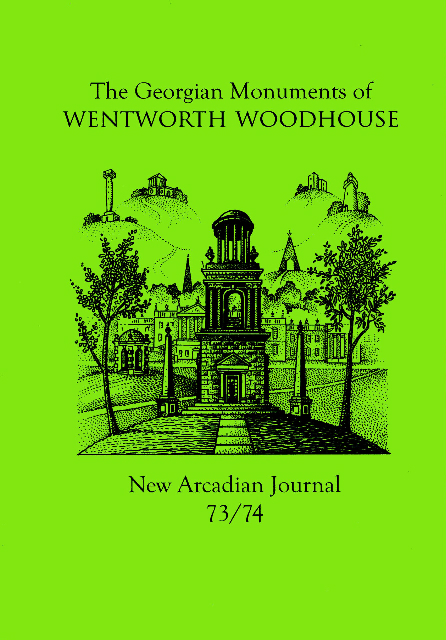One of three co-founders and now sole editor and publisher, Patrick Eyres has stamped his personality on the feisty, visually distinctive and intellectually robust New Arcadian Journal, which takes as its primary battleground the cultural politics of eighteenth-century historical landscapes, and especially their man-made iconography. Adding a modern resonance are disquisitions on garden works by contemporary artists, notably the late Scottish garden-maker, artist and concrete poet, Ian Hamilton Finlay …
Originally a quarterly, NAJ has evolved into a compact double issue around a single theme, published annually in a numbered edition limited to 300 copies. Image and text confidently complement each other, from the bright, single-colour covers and contrasting flyleaves, to the starkly black-and-white illustrations in a variety of styles that happily mix pointillist bird’s-eye panoramas (by Chris Broughton); fluid, John Piperesque line drawings of structures, foliage and occasional interiors (by Catherine Aldred); rapid architectural doodles (by Mark Stewart); carefully observed statues (by the sculpture conservator, Andrew Naylor); and vignettes of (preferably salacious) art and architecture by Howard Eaglestone, who lists his interests as “sex, shipping and gliders”. These and other artworks proclaim NAJ’s core qualities: eclectic, obsessive, bellicose (war planes flying low over Georgian statuary is a very New Arcadian image), and refreshingly original in its determination to offer a modern and highly particular reading of old landscapes. Even vanished garden layouts are redrawn afresh.
Sex and gardens is a recurring theme, most obviously in the millennium issue (2000, volume 49/50), ‘Gardens of Desire’, which took as its focus Sir Francis Dashwood’s notoriously licentious landscapes at West Wycombe and neighbouring Medmenham Abbey, eschewing straight garden history for a more embattled engagement with “the sexuality of the Georgian garden and the variety of positions offered by … ‘laddish’ modes of interpretation”. Prompted by the architectural historian Dan Cruikshank’s challenge to the National Trust to stop sanitizing its Georgian gardens, Patrick Eyres set the tone in his editorial: pugnacious polemic underpinned by rigorous scholarship. Two contributors then played around with this theme: first, the clever and laddish Richard Wheeler, who used his long experience as National Trust regional land agent to unearth antecedents at Stowe for Dashwood’s bawdy garden features, among them a Mound of Venus “quite biological in its architectural detail”. Next came the perceptive and determinedly unlad-dish cultural historian Wendy Frith, who introduced the wider backdrop of eighteenth-century sexual politics, which saw aristocratic excess increasingly challenged by bourgeois moderation. Howard Eaglestone reconstructed with relish the lost Medmenham statues, while Andrew Naylor injected a professional conservator’s view on the reclamation of Georgian lead sculpture, originally painted to resemble marble, in an appendix entitled ‘Upgrading Erections’.
The current issue (2008, volume 63/64) returns to the journal’s Yorkshire roots and the Georgian Landscape of Wentworth Castle, under restoration as a “major site of Georgian political and aesthetic modernity; indeed, as a national treasure”. Eyres likes nothing better than a good scrap, and at Wentworth the rivalry was familial as well as political, concerning a disputed inheritance and subsequent skirmishing … between the neighbouring estates of Wentworth Castle and Wentworth Woodhouse. As a mark of NAJ’s continuing interest in the restoration, Eyres introduces multiple viewpoints from six different contributors (including himself), who combine the journal’s familiar polemic with a more traditional exposition of early eighteenth-century wildernesses by the academic and landscape design consultant, Jan Woudstra …
Jennifer Potter, TLS, 31 October 2008



